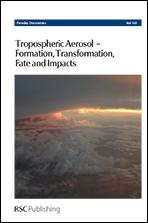Brown carbon formation from ketoaldehydes of biogenic monoterpenes†
Abstract
Sources and chemical composition of brown carbon are poorly understood, and even less is known about the mechanisms of its atmospheric transformations. This work presents molecular-level investigations of the reactive compound ketolimononaldehyde (KLA, C9H14O3), a second-generation ozonolysis product of limonene (C10H16), as a potent brown carbon precursor in secondary organic aerosol (SOA) through its reactions with reduced nitrogen compounds, such as ammonium ion (NH4+), ammonia, and amino acids. The reactions of synthesized and purified KLA with NH4+ and glycine resulted in the formation of chromophores nearly identical in spectral properties and formation rates to those found in similarly-aged limonene/O3 SOA. Similar chemical reaction processes of limononaldehyde (LA, C10H16O2) and pinonaldehyde (PA, C10H16O2), the first-generation ozonolysis products of limonene and α-pinene, respectively, were also studied, but the resulting products did not exhibit the light absorption properties of brown carbon, suggesting that the unique molecular structure of KLA produces visible-light-absorbing compounds. The KLA/NH4+ and KLA/GLY reactions produce water-soluble, hydrolysis-resilient chromophores with high mass absorption coefficients (MAC = 2000–4000 cm2 g−1) at λ ∼ 500 nm, precisely at the maximum of the solar emission spectrum. Liquid chromatography was used to isolate the light-absorbing fraction, and UV-Vis, FTIR, NMR and high-resolution mass spectrometry (HR-MS) techniques were used to investigate the structures and chemical properties of the light-absorbing compounds. The KLA browning reaction generates a diverse mixture of light-absorbing compounds, with the majority of the observable products containing 1–4 units of KLA and 0–2 nitrogen atoms. Based on the HR-MS product distribution, conjugated aldol condensates, secondary imines (Schiff bases), and N-heterocycles like pyrroles may contribute in varying degree to the light-absorbing properties of the KLA brown carbon. The results of this study demonstrate the high degree of selectivity of organic compound structures on the light-absorbing properties of SOA.
- This article is part of the themed collection: Tropospheric Aerosol – Formation, Transformation and Impacts

 Please wait while we load your content...
Please wait while we load your content...